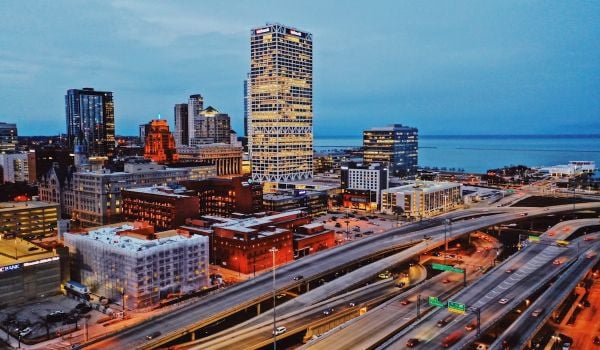It was supposed to be Milwaukee’s big “coming out” party, when the Brew City revealed to the rest of the world a new side to its identity. Studies had shown time and again that just about the only thing people consistently thought of when they heard the word “Milwaukee” was “beer.” When the city was set to unveil a new addition to its art museum, the first building in the Western Hemisphere designed by the up-and-coming starchitect Santiago Calatrava, the national press and cable news channels were signed on to be there, and city leaders geared up to herald the arrival of a “new Milwaukee.”
You can be forgiven for having no recollection of this big event, for by the time the building was officially open, October 2001, the national media had moved on to more pressing matters: the aftermath of the 9/11 attacks, a new round of anthrax attacks and a new “war on terror.”
Indeed, security was tight when MAM’s new addition opened to the public. Ironically, a building that had promised to a be the city’s new gathering place charged admission just to walk into its grand, sweeping common areas, lest any ne’er do wells sneak past security. But the new art museum addition was an instant hit — a new icon for the city. It promised to do for Milwaukee what the Gateway Arch did for St. Louis and the Golden Gate Bridge did for San Francisco.
Now, nearly seven years later, the most obvious post-9/11 security measures have gone by the wayside, and anyone, paying customer or not, can walk into MAM’s bold, expansive atrium. I myself have walked in this atrium countless times over the last seven years, and it has never gotten old. Of all the places I’ve been to, I would still call Calatrava’s Milwaukee Art Museum addition one of the most stirring public spaces in America. It’s the kind of building you can see nearly every day, but still see something new everytime you look at it.
But, seven years later, has the new and improved MAM really done what it was promised to: usher in a renaissance for the city? How much can one building, no matter how bold, change a city’s image? Or change a city?
To be sure, the MAM addition has taken its place alongside beer and baseball as central to the city’s self image. It’s featured in the backdrop of most local TV news sets, comprises the city’s official tourism logo, and has become so well known that us locals call it simply “the Calatrava.”
The Calatrava has given us something else to talk about with out of towners besides beer, and has given people throughout the region, and indeed the world, a legitimate reason to make a visit to Milwaukee. It’s now not uncommon to see a camera-wielding European or Asian tourist walking the streets of Downtown Milwaukee. Any long-time Milwaukeean will tell you that you would have never seen that before the Calatrava. The building’s prominence in the art world has helped MAM develop partnerships with European art houses, bringing traveling exhibitions through town that would have never previously made stops in Milwaukee.
And there’s no doubt that the Calatrava has had tangible, bricks and mortar effects on its immediate surroundings, and perhaps Downtown in general. Condo towers full of the priciest per-foot real estate in the state rise just north of MAM, capitalizing on the world class view. The once-tired swath of Lake Michigan shoreline immediately south of the Calatrava, once the site of crumbling parking lots and piles of rocks, has now been spruced up, housing a new science museum and lakefront park. A new class A office building rises just to the west, leased to blue chip investment firms interested in the view.
But what of a larger renassiance? Here’s where things get a little trickier. It’s true that the US Census estimates the city’s population has increased slightly over the course this decade – the first population increase in 40 years. City leaders cite the residential boom in Downtown and surrounding neighborhoods for this growth, and one could argue that the Calatrava played a key role in this residential boom. So has the Calatrava actually led to population growth in Milwaukee? Not so fast. We won’t know until 2010 if the estimate holds up to the Census’s “official” count, and even then, whether the population increase is indeed attributable to the Downtown residential boom.
Then, of course, there are things like crime, poverty, and failing schools. Crime is down from its historic highs, but actually up slightly from 2001 when the Calatrava opened. And, since the Calatrava opened, Milwaukee has seen no decrease in poverty, and the gap in achievement between low income and middle income students is among the highest in the nation.
But, really, no one ever expected the Calatrava to change Milwaukee that much. To expect that would be to expect a building with almost magical transformative powers, right?
The Calatrava has transformed its city as much as one building could be expected to. Privately funded, it has been a resounding win for the city. There are many who would agree that Milwaukee has indeed entered a new era, and that the Calatrava led the way. But there’s a limit to how much the city has actually changed in the last decade – changes that no cultural institution could be expected to bring about.
Maybe that’s part of the problem: expectations. And how we define “renassiance.” We have brought about a “new Milwaukee” with the Calatrava as its centerpiece. But why can’t we have the same great expectations for the other city that lies in the new city’s shadows?









